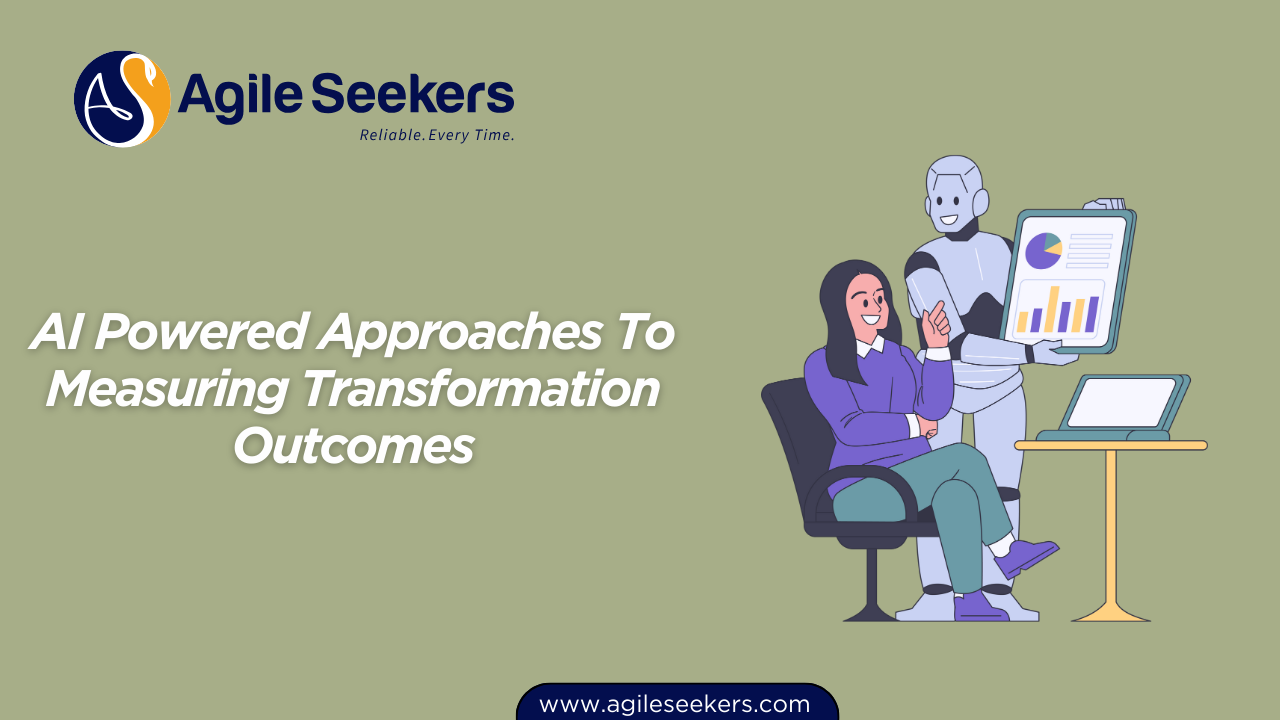AI Powered Approaches To Measuring Transformation Outcomes

Digital and agile transformations promise big changes—improved delivery, better collaboration, and stronger business outcomes. But here’s the challenge: how do you measure whether the transformation is actually working? Traditional KPIs often miss the full picture. That’s where AI-powered approaches bring clarity, speed, and sharper insights.
This post unpacks how AI transforms the way organizations measure outcomes, track progress, and sustain momentum.
Why Measuring Transformation Outcomes Is Hard
-
Lagging indicators dominate. Companies often rely on financial or delivery metrics that appear months after the actual change.
-
Too much noise, not enough signal. Agile transformations generate mountains of data—standups, sprint velocity, backlog flow, employee surveys—but leaders struggle to interpret what matters.
-
Human bias creeps in. Progress reports often reflect optimism or politics more than reality.
AI addresses these issues by making measurement continuous, predictive, and less prone to bias.
The Role of AI in Transformation Measurement
AI doesn’t just automate reporting; it changes what can be measured and how.
-
Real-time progress tracking
Machine learning models can process daily data from agile tools like Jira, Rally, or Azure DevOps. Instead of waiting for quarterly reports, leaders see progress week by week. -
Sentiment and culture analysis
AI-powered text and speech analytics can interpret how teams feel about the change. Employee feedback, Slack messages, or retrospective notes become a measurable signal of cultural adoption. -
Predictive insights
AI can forecast delivery risks, bottlenecks, or burnout before they surface. This allows leaders to act early, keeping the transformation on track. -
Value stream visibility
By connecting metrics across teams, AI highlights whether value flows smoothly from idea to customer. Instead of focusing only on team velocity, leaders can see how the entire system delivers outcomes.
AI-Powered Metrics That Matter
Not every number drives transformation success. AI makes it possible to capture metrics that were previously invisible or too complex to track.
-
Flow metrics
-
Lead time
-
Throughput
-
Work in progress (WIP) patterns
AI connects these to customer value, not just output.
-
-
Engagement signals
NLP models analyze communication platforms to spot collaboration levels, trust indicators, or even fatigue trends. -
Business impact links
By combining agile metrics with financial and customer data, AI shows whether improved delivery actually drives revenue, cost savings, or customer satisfaction. -
Resilience measures
Transformation isn’t just about speed. AI can model how adaptive teams are when priorities shift, giving leaders a resilience score.
How Leaders, Managers, and Teams Benefit
-
For Change Agents and Leaders
Transformation leaders need evidence of impact to keep executives invested. AI-powered dashboards give them a clear view of cultural adoption, business outcomes, and momentum.
→ To go deeper, see AI for Agile Leaders & Change Agents Certification. -
For Project Managers
AI automates risk tracking, portfolio health checks, and dependency mapping. Instead of spending hours chasing updates, project managers focus on enabling decisions.
→ Learn more at AI for Project Managers Certification Training. -
For Product Owners
AI aligns product roadmaps with customer data. It can show whether backlog items connect to measurable outcomes, not just delivery dates.
→ Explore AI for Product Owners Certification Training. -
For Scrum Masters
AI helps Scrum Masters spot team health issues early—burnout, uneven workload, or anti-patterns in ceremonies. They gain tools to coach more effectively with data, not just gut feeling.
→ Check out AI for Scrum Masters Training.
Practical AI Techniques for Outcome Measurement
-
Natural Language Processing (NLP)
Used for analyzing retrospectives, feedback surveys, or stakeholder comments. It identifies recurring themes, risks, or morale signals. -
Predictive Analytics
Models estimate whether a project or initiative will meet goals based on historical patterns and real-time inputs. -
Machine Learning for Risk Identification
Algorithms scan dependencies, backlogs, and velocity data to flag where delays might occur. -
Automated Dashboards
AI-driven dashboards combine qualitative and quantitative data into one view. Leaders don’t just see “burndown charts”—they see how delivery connects to strategy.
Case Example: Linking Transformation to Business Value
Imagine a financial services company rolling out Agile across 30 teams.
-
Old way: They measured story points completed per sprint and employee satisfaction surveys every quarter.
-
AI-enhanced way:
-
Flow analytics reveal that teams reduce lead time by 20%.
-
Sentiment analysis shows improved trust in leadership.
-
Linking agile data with customer NPS shows higher satisfaction with new product launches.
-
The shift isn’t about replacing traditional KPIs—it’s about expanding visibility into outcomes that matter.
External Insights Worth Exploring
AI in transformation isn’t a siloed practice. It builds on broader fields of research:
These resources highlight the evolving role of AI in shaping transformation at scale.
Building AI Literacy Across Roles
Success with AI-powered measurement depends on more than tools. Leaders, managers, and teams need AI literacy—the ability to interpret data, question assumptions, and act on insights. Without this, dashboards risk becoming noise.
Training programs that focus on AI in Agile contexts ensure people know how to:
-
Translate AI signals into meaningful conversations.
-
Balance data with human judgment.
-
Keep ethical considerations in mind when analyzing team behaviors.
Conclusion
Measuring transformation outcomes has always been a balancing act between numbers, stories, and impact. AI doesn’t replace human judgment—it enhances it. By making invisible patterns visible, forecasting risks, and connecting delivery with business results, AI gives leaders and teams the clarity they need to sustain transformation.
The organizations that embrace AI-powered measurement won’t just know whether they’re “doing Agile.” They’ll know whether they’re achieving the outcomes that matter most—faster, more reliably, and with greater confidence.
Also read - Building Trust In Agile Organizations With AI Driven Transparency
Also see - The Role Of AI In Identifying And Removing Agile Bottlenecks




















